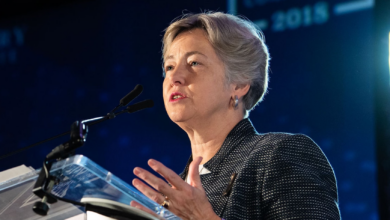
Princess Diana and the Gays
Through her life, she taught us how to treat people living with AIDS with compassion. Through her death, she changed the character of a nation.
By Andrew Edmonson
It was a seminal moment in the 1990s: abrupt, shocking, and tragic.
On Sunday, August 31, 1997, Americans awoke to discover that Diana, Princess of Wales, had been killed in a car crash in Paris, pursued by the paparazzi who had relentlessly hounded her for years.
A decade before the widespread embrace of social media, a wave of grief convulsed the Western world, stunned at the loss of the beloved British royal who died at the impossibly young age of 36 and was arguably the best known woman in the world.
For gay men, the loss was especially stinging. Through the worst years of the AIDS crisis, when fear and loathing dominated the public discourse in the late 1980s, she stood strongly with gay men. She used her position, charisma, and the extraordinary media attention that she commanded to show the world how to treat people living with HIV with compassion and dignity.
“I found myself being more and more involved with people who were rejected by society,” she stated of that period in her life in the mid-1980s, when her marriage began to fall apart and when AIDS reached epidemic proportions. “I found an affinity there. I respected very much the honesty on that level of the people I met. When I would sit on the beds and saw the reassurance that that gave, I did it everywhere.”
In April 1987, she went to open the first purpose built HIV/AIDS unit at Middlesex Hospital in London. In front of the world’s media, she shook the hand of a man suffering from the illness, without a glove. It was a turning point moment in educating the public that AIDS could not be transmitted through casual contact.
“People were really frightened because we didn’t know what it [AIDS] was to begin with. There was a lot of AIDS phobia and homophobia,” former AIDS nurse John O’Reilly, who worked at Middlesex Hospital, told the BBC. “For everybody affected by AIDS around the world, it [Diana shaking the hands of a patient with AIDS] was a major coup. It was amazing.”
It was also an act that surprised and shocked Buckingham Palace, which vehemently opposed the idea a member of the royal family being associated with a controversial disease afflicting primarily gay men.
“This episode however marked a significant change for Diana,” remarked Andrew Morton, her official biographer. “She now realized that she could use her public persona as a force for change and for good.”
In February 1989 while in New York City, she visited Harlem Hospital, and spontaneously picked up a 7-year-old boy with AIDS, cradling him lovingly in her arms for several minutes. At home in the United Kingdom, when the cameras were turned off, Diana would make late night visits to the AIDS wards of London hospitals to comfort gay men as they lay dying.
“Whatever the Queen might think, from this time onwards Diana began to champion the causes of those who were dispossessed and isolated in society,” says Morton. “In short she had found her royal vocation.”
_________________
The day after she died, a, small impromptu shrine to her appeared in Montrose, the heart of Houston’s gay community. LGBTQ Houstonians and their friends spontaneously brought candles, flowers, portraits of Diana, red AIDS ribbons and other mementoes to pay tribute to the People’s Princess. The memorial grew and grew in the week preceding her funeral until it came to dominate the intersection of Montrose and Westheimer.
Her death transformed the national character of Britain. The world watched transfixed by the public outpouring of deep sorrow in London as thousands of Britons spontaneously flocked to Kensington Palace to heap flowers in tribute to Diana, and angrily demand that Queen Elizabeth II return from her seclusion at Balmoral Castle in Scotland to be with her grieving subjects in London.
For at least 50 years since its heroism during the Second World War, England was renowned for its stiff upper lip and stoic reserve. In that extraordinary week’s time, Britons seemed transformed into a more modern, emotionally demonstrative people who were liberated by catharsis.
Writing in The Guardian of London on August 22, 1998, almost a year after Diana’s death, Scottish journalist Andrew Marr summed it up thusly:
Think back to that late-summer convulsion when the starkness of Diana’s death folded into scenes of spontaneous mass-mourning on the hot streets of London, accompanied by equally heated debates about the future of the monarchy and the true nature of the British people. …
What is real is that, with Diana’s death, Britain suddenly stared at itself in the mirror and didn’t quite recognize the face looking back. No longer was the expression tight-lipped, white, and drawn with reticence. Diana was the queen of another country, a multi-cultural, more liberal and emotionally open Britain, the patron saint of the pierced people who are all around us.
In the two decades since her death, her sons have embraced her legacy, supporting AIDS charities in Britain, and demonstrating their mother’s trademark compassion and humanity. Recently, they spoke movingly about the trauma of the loss of their mother. Prince Harry has disclosed that he sought counseling after having shut himself down emotionally for two decades after Diana’s death.
His courage in making this revelation bears witness to the humanity and the candor that was Diana unique contribution to the royal family, and the way that she forever changed that institution.
Their mother would be proud.










